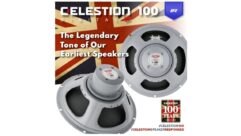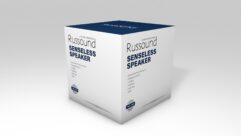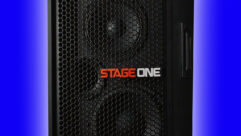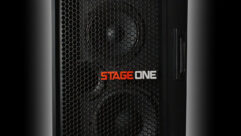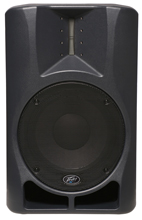

Peavey Impulse 12D Speaker Review
Jun 27, 2012 11:50 AM,
Reviewer: John McJunkin
A compact, pole-mounted, internally amplified speaker that leverages Peavey’s planar ribbon driver technology.
A lot of manufacturers are making compact, pole-mounted self-powered speakers intended for a broad array of applications—for coffee shops, portable deejays, small concert venues, just to name a few. The range of quality across the brands and models of these speakers is also broad, and some manufacturers have realized that in order to stand out in this ocean of products, they need to raise the bar in terms of quality. The build quality (and hence roadworthiness) needs to be very good, and the quality of the audio must also be very high, which is usually even more important than the build attributes. Among the various components that determine the quality of the system, the standouts are: design, construction, and composition of the cabinet, drivers and amplifiers, the electronics—including crossovers and equalization—and even mic pre-amps and compressors in more sophisticated speakers. Some of the manufacturers go all out, maximizing all of these factors, and usually the cost to the enduser of this thorough approach is, well, the cost. Other manufacturers work to thread the needle by putting more focus on one component or another to wrest more quality, but perhaps at a lower price. And of course, some manufacturers have products that are simply intended to exhibit the maximum quality possible despite the very low price. The old maxim applies nearly 100 percent of the time: You get what you pay for. Peavey’s latest entry into this domain leans toward the higher quality end of this spectrum, if for no other reason than its unique-to-the-range ribbon high frequency driver.
Peavey Electronics has introduced the Impulse 12D, a compact, pole-mounted, internally amplified speaker. As is usually the case, the speaker can also be flown or used as a floor-wedge monitor in addition to its typical pole mounting. Peavey has enjoyed success with its Versarray series, with its planar ribbon high-frequency drivers, and recognized that they could leverage those ribbon drivers, in a smaller, less costly speaker that would appeal to a wider range of potential users. Hence the ribbon driver became the standout component in the Impulse 12D. And there are other areas in which the speaker shines. It employs Class D amplification—a whole lot of it—to power its drivers, including a dual voice-coil low-frequency driver, with 1200W of Class D power available to it. It also sports a feature-rich input/output section, with modest mixing capabilities, compensation EQ for different applications, and a loop-through connection to facilitate the use of several units together. The speaker offers some great features, and I had been excited to hear these ribbon drivers incorporated into a speaker-on-a-stick, so I was thrilled to receive the shipment, unbox the speakers, and get started listening.
I mounted the speakers on poles, connected power, and linked up the output of a modest 16-channel, four-bus mixer. My rationale was that this type of speaker is typically going to be fed a signal by a smaller mixer like this, or maybe even something less sophisticated. I listened to an array of sources, including speaking and singing into a live microphone, miked musical instruments, and recorded music in both MP3 and CD formats. Initially, I left the signal completely flat throughout the chain, from source to speaker—despite numerous EQ opportunities: onboard the MP3 player, channel and stereo bus EQ in the mixer, and the three compensation curves available on the speakers themselves. With no equalization applied whatsoever, my initial impression was, “Wow! Listen to that high end!” While the quantity of high end was a touch more than I like, the quality was also just a bit crisp to my ears. So I started applying a little EQ—just shaving away at the high end—and after I took 8kHz down just a touch with a graphic, it started to sound better, but when I went on to take off a little less than 3dB above 12kHz with a shelving type EQ, it really started to sound amazing. High-hats sounded nice, tight, and crisp, and a pleasant sense of open airiness happened. It dawned on me that I had never even seen ribbon drivers in a speaker-on-a-stick, much less worked with them, and it would be foolish for me to expect them to sound and behave like typical high-compression drivers. These ribbons lend an overall sheen to the high-end, and on first blush, it also seems as if the high end is hyped a bit. But while these drivers deliver more quantitatively, I would submit that they also deliver more qualitatively as well. The high end was more defined than what I was accustomed to hearing, and I believe that this contributes a bit to the illusion that the high end overpowers the low end.
I had commenced my listening exercise in a relatively small interior space, but once I graduated to larger interiors, and eventually exterior space, it also became apparent to me that the seemingly crispy high end gives way to creamy, well-defined high end at greater distances from the driver. As you get farther from the speakers, that brightness tapers off and you start thinking, “Oh yeah, that’s what I wanted to hear.” The speakers’ dispersion pattern is 100 degrees horizontal and 30 degrees vertical, and it’s pretty nicely controlled, if you need to restrict it. I still wound up applying some EQ, shaving off just a bit of the high end, but who doesn’t? There’s no such thing as a speaker designed in such a way that its spectral dispersion works perfectly in every environment, so we do EQ to compensate.
Once the EQ is dialed in for the environment, I really like the way these speakers sound. There is a bit of a tubby kind of resonance around 250-300Hz, but it’s easily tamped down with EQ as well. Considering the size of the cabinet and the 12in. LF driver, it produces a solid quantity of low end, but the story here is the dual voice coil, which gives the amplifier much more control over the motion of the driver than a single voice coil. The result is clean, tight bass. The driver’s cone doesn’t flop wildly; it moves the way the amp tells it to, and the result is very pleasant. I swept the speaker with a tone generator, and I concluded that the manufacturer’s claim that the lowest usable frequency is 60Hz is a fair assessment. If you want deep-dish low end, you’ll want to marry these speakers to a subwoofer.
My only minor criticism of the speakers is the self-noise of the amp-speaker combination. When I first applied power to these speakers, I definitely noticed the noise floor. The source of this noise is the totality of the system, from input circuitry to the amp to the output processing, but most of it can be attributed to the eagerness of the HF drivers. Obviously, once a substantial signal is applied, the noise floor is buried (at least with most pop or rock music), but with very quiet passages in classical or jazz music, the noise is a bit distracting. And as I said before, the apparent extra brightness of these speakers dissipates with distance from the speakers, and the self-noise is only really distracting when the listener is up close and really personal with the speaker. In most of the applications for which this speaker will be used, that distance will be a given. Finally on the topic of self-noise, I talked to the folks at Peavey, who are already working on the next revision of the speaker, and they are addressing this issue.
Bottom line, once a realtime analyzer is used to dial in a proper response with these speakers, they leverage the smooth, consistent delivery of ribbon drivers to present a very pleasing listening experience with ample sound pressure level and a broad dispersion pattern. I’m not aware of any other manufacturer that has boldly included a ribbon driver in this type of speaker to date, and it’s a brilliant stroke on the part of Peavey. Future revisions of the speaker will iron out some initial wrinkles and result in an absolutely incredible speaker. Even now, as long as you’re not afraid to apply just a little equalization to your stereo bus (and I bet you already do), these speakers represent a great value. I recommend taking the time to hear them. They’re worthy of your consideration.
Product Summary
Pros: Loud, clear, powerful, lightweight, versatile input/mixing section
Cons: Considerable self-noise, ribbon tweeters overstate high end
Applications: DJs, karaoke, coffee-shop guitar/vocal, public address
Price: $1,149.99 (MSRP) ($799.99 MAP)
Specifications:
Frequency response: 52Hz to 20kHz
Internal power amplifiers (@120 VAC line)
Woofer: 1200W peak available power; continuous power: 550W @ less than 1% distortion
Tweeter: 150W peak available power; continuous power: 75W @ less than 1% distortion
Nominal sensitivity: 100dB (average – 1W @1M, swept sine input in anechoic environment)
Maximum sound pressure level: 131dB music peak
Nominal radiation angles: 100˚ horizontal x 30˚ vertical
Electroacoustic crossover frequency: 2kHz
Crossover type: Internal Electronic two-way crossover with driver EQ, level matching, bass boost, and subsonic filtering.
Crossover slopes: 24dB/octave (fourth order) low pass 24dB/octave (fourth order) high pass both with staggered poles and driver EQ. Horn spatially aligned with woofer, so there is no need for phase alignment or time delay of the signals
Electronic input impedance (nominal): 10kΩ unbalanced; 20kΩ balanced line level; 2.4kΩ balanced mic level
Dimensions (HxWxD): Front: 24.89”x15.63”x15.38”
Rear (HxW): 23.13”x7.50” (13.50” at 2nd angle break)
Weight: 39lbs.
Nominal amplifier frequency response: ±1dB from 10Hz to 20kHz
Hum and noise: >90dB below rated power
DDT dynamic range: >22 dB
THD and IM: Typically <0.1%
Damping factor: >100 @ 1kHz, 8Ω
Power requirements: Nominal 700W, 120VAC, 60Hz
John McJunkin is the principal of Avalon Podcasting in Chandler, Ariz. He has consulted in the development of studios and installations and provides high-quality podcast-production services.



